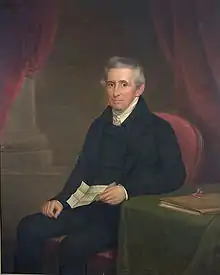Thomas P. Ives House
The Thomas P. Ives House is a National Historic Landmark at 66 Power Street in the College Hill in Providence, Rhode Island. Built in 1803–06, this brick house is an extremely well-preserved and little-altered example of Adamesque-Federal style. The house was built by Caleb Ormsbee, a Providence master builder, for Thomas Poynton Ives, a wealthy merchant. Although two of its principal chambers were redecorated in the 1870s, these alterations were reversed in the 1950s. The house was in Ives family hands for more than 150 years, and is now owned by Brown University. It was designated a National Historic Landmark on December 30, 1970.[2]
Thomas P. Ives House | |
.jpg.webp) Thomas P. Ives House | |
  | |
| Location | 66 Power St., Providence, Rhode Island |
|---|---|
| Coordinates | 41°49′24″N 71°24′10″W |
| Built | 1803–1806 |
| Architect | Caleb Ormsbee |
| Architectural style | Federal, Adamesque, American Federal |
| Part of | College Hill Historic District (ID70000019) |
| NRHP reference No. | 70000023 |
| Significant dates | |
| Added to NRHP | December 30, 1970[1] |
| Designated NHL | December 30, 1970[2] |
| Designated NHLDCP | November 10, 1970 |
Description
The Ives House is a 3 1⁄2-story brick structure, with a hip roof surrounded by a low balustrade. The front facade and sides are laid in Flemish bond, while the back wall is laid in American bond. The front is five bays wide, with a single-story circular porch (an 1884 addition) sheltering the centered entry. The doorway is flanked by sidelight windows and topped by an elliptical fanlight. On the right side of the house is a projecting bay, which originally was a single story but now rises the full three stories. The main roof cornice is modillioned.[3]
The first floor of the interior is a grand and imposing presence. The central hallway is ten feet wide, with rooms on either side and a stairway that spirals upward. The main parlor is to the right, with an oval library in the center, and a smoking room at the back. On the left is the dining room, with a pantry and kitchen behind. The public rooms are decorated in delicate Adamesque woodwork, with the parlor and dining room also featuring particularly elaborate plaster decoration.[3]
History

Thomas Poynton Ives (1759–1835) was a wealthy merchant, who received his training in the counting house of Nicholas Brown, Sr., married Brown's daughter Hope, and in 1796 former the partnership of Brown & Ives with Nicholas Brown, Jr., for whom Brown University is named.[4] Ives hired Caleb Ormsbee to build this house, which was built between 1803 and 1806.[3] The house remained in the hands of the Ives family until 1910. At that time it was sold to Brown University, retaining a lifetime occupancy right for owners.[5]
The house underwent a number of relatively modest alterations. Gas lighting and central heat were added in 1848, and French doors were added to the library in 1910. The most significant ones occurred in the 1870s, when the dining room and library were redecorated in the Colonial Revival style. This work was removed in 1954, replaced by Federal styling more in keeping with the rest of the house. A period fireplace mantel from Philadelphia was installed in the dining room as part of this work.[3]
The house was designated a National Historic Landmark and listed on the National Register of Historic Places in 1970;[1] it was included as a contributing property to the expansive College Hill Historic District, a National Historic Landmark District encompassing the original colonial center of Providence.[6]
Gallery
 Winter 2011
Winter 2011 Spring 2011
Spring 2011.jpg.webp) House in 1937
House in 1937- Main Stairway at the first floor in 1958
- Stable and Coach houses, 1958
See also
References
- "National Register Information System". National Register of Historic Places. National Park Service. April 15, 2008.
- "Ives, Thomas P., House". National Historic Landmark summary listing. National Park Service. Retrieved 2008-06-28.
- "NHL nomination for Thomas P. Ives House". National Park Service. Retrieved 2014-10-14.
- "Guide to the Brown and Ives records 1794–1914" (PDF). John Carter Brown Library. Retrieved 2014-10-14.
- "Written Historical and Descriptive Data, HABS records for Thomas P. Ives House" (PDF). Library of Congress. Retrieved 2014-10-14.
- "NHL nomination for College Hill Historic District" (PDF). Rhode Island Preservation. Retrieved 2014-10-14.
External links
 Media related to Thomas P. Ives House at Wikimedia Commons
Media related to Thomas P. Ives House at Wikimedia Commons- Historic American Buildings Survey (HABS) No. RI-235, "Thomas P. Ives House, 66 Power Street, Providence, Providence County, RI", 7 photos, 8 data pages